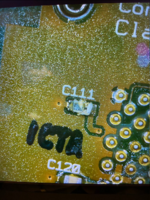KGLlewellyn
Well-known member
Hey folks,
I've got a 820-0720-B Pentium PCI Compatibility card, I believe it's the 100Mhz model. I've been using it flawlessly in my Power Mac 4400 via the GIMO slot for the last few months. Out of nowhere today when I went to boot it up it gave me a couple of short beeps and didn't respond. I rebooted the card, and now when the Mac switches to the card I get no beeps and the monitor goes to 'No Signal'. After some finagling, I was able to get it to boot, but the graphics looked a bit corrupted. But now it's back again to no-beep, and PCSetup is stuck on 'PC is Booting'. The card hasn't been recapped or anything, but is anyone aware of any common failures that hit this card?
I'm not really in a position to try this out in another Mac as I lack the Y-Cable, I only have the GIMO cable and adapter sadly.
I've got a 820-0720-B Pentium PCI Compatibility card, I believe it's the 100Mhz model. I've been using it flawlessly in my Power Mac 4400 via the GIMO slot for the last few months. Out of nowhere today when I went to boot it up it gave me a couple of short beeps and didn't respond. I rebooted the card, and now when the Mac switches to the card I get no beeps and the monitor goes to 'No Signal'. After some finagling, I was able to get it to boot, but the graphics looked a bit corrupted. But now it's back again to no-beep, and PCSetup is stuck on 'PC is Booting'. The card hasn't been recapped or anything, but is anyone aware of any common failures that hit this card?
I'm not really in a position to try this out in another Mac as I lack the Y-Cable, I only have the GIMO cable and adapter sadly.


